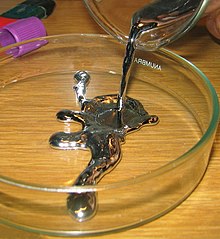Rasalingam
This article has multiple issues. Please help improve it or discuss these issues on the talk page. (Learn how and when to remove these template messages)
|
| Part of a series on |
| Shaivism |
|---|
 |
|
|

In Hinduism, Rasalingam or Parad Lingam is a Lingam, the symbol of the god Shiva, made of mercury (or possibly Gallium; see Composition below.) Tamil Siddhas carved Shiva Lingam from solidified mercury. The process of solidification of mercury is the secret process enunciated by Tamil Siddhas. In Tamil, mercury is called Pada-rasam and the Shiva Lingam made using pada-rasam is called Rasalingam. In Sanskrit, mercury is called Parad and the Shiva Lingam made using parad is called Parad Lingam. Rasalingams or Parad Lingams are consecrated in Hindu Shiva temples, Ashrams and other places of worships.
Siddhic beliefs
Shiva Puja must be performed with linga. The Rasalingam has a place in the worship of Shiva.[1][2] Tamil Siddhas identify mercury as Shiva's metal (Shivadhatu). According to Siddha alchemy, mercury is the representation of male (Shiva) form, and the chemical element sulfur associated in the solidification process is considered as the representation of female (Shakti or Gauri, consort of Shiva) form.[3]
Notable rasalinga
Masilamaniswara Temple, Thirumullaivoyal

Kodiyidai Amman Sametha Masilamaniswara Temple is situated at Thirumullaivoyal, a small town forming part of west Chennai and the temple is 2 km away from Ambattur. The prime deity Shiva at this temple was incarnated by the hymns of Sundarar, Ramalinga Adigalar and Arunagirinathar. A Rasalingam is installed in the second corridor near sanctum sanctorum of Shiva. The huge Shiva Linga in the sanctum sanctorum is covered with sandal paste. Every year in the month of Chittirai (Mar-Apr), on Sadaya nakshatra (Sadayam star), the Santhana kappu (sandal paste cover) is refurbished with Veru kappu.[4]
Shiva Temple, Visakhapatnam

Shiva temple is located in Visakhapatnam (also known as Vizag and Waltair), the first largest city in Andhra Pradesh. The temple is situated on Rama Krishna Beach road. The uniqueness of this Siva Temple is its Rasalingam, which is made of a 10 kg single stone.[5]
Siddha Ashram, Ujjain
Siddha Ashram is located near to Harsiddhi Temple in Ujjain, Madhya Pradesh, India. The area contains a temple, meditation chamber and gardens, and attracts hundreds visitors each year.[citation needed] The World's Larrgest Paredeshvar temple at the ashram is unique. It houses a mercury (parad) shivalinga which weighs 2500 kilograms, the largest of its kind in the world. The ashram is run by Acharya Mahamandaleshwara Swami Nardanandji who is known for his Kundalini Shaktipath initiation and research into ayurvedic based medicinal remedies.[6] Siddha Ashram has consecrated the world’s largest Parad Lingam weighing about 2500 kg. during November, 2005. The Parad Lingam temple is located at Ashram complex. People are allowed to see, touch and worship this Lingam.[7]
Dhyanalinga and Theerthakund, Coimbatore
The Dhyanalinga is a
Sri Dattashram, Anksapoor Village, Velpoor mandal, Nizamabad dist, Telangana
At Dattashram Anksapoor village near Nizamabad in Telangana a Rasalingam, one of the huge rasalingam weighing about 411 kg. was consecrated on April 25, 2004 by the Jagadguru Pushpagiri Shankaracharya and Hampi Virupaksha Vidyaranya Peethadhipati. The Rs.6 lakh worth Rasalingam was brought from Banaras, Uttar Pradesh. It is a world largest rasalingam. The temple was established by pujya sri vittal goud (bapu) maharaj.[11]
Paradeswar Temple in Dharamgarh
Paradeswar Siva Temple located in
Composition
Rasalingam is likely an amalgam alloyed with gallium, a liquid metal with properties similar to, but not as toxic as, mercury. The density of rasalingam is approximately 6g/cc,[13] far below the density of mercury, at above 14g/cc. This matches the density of gallium, which melts at 29.6 degrees Celsius, just above the typically cooler temperatures in India.[14] It is also notable that India imports, rather than exports, mercury, and is not a major producer of it.[15][16] India is, however, the fifth most prolific exporter of bauxite, from which gallium is extracted.[17]
References
- ISBN 9788176252263. Retrieved 2012-05-04.
- ^ Parad Shiva lingam Archived 2012-06-06 at the Wayback Machine
- ^ இரசவாதம் - ரசமணியும், ரசலிங்கமும்.
- ^ மாசிலாமணி ஈஸ்வரர் கோவில், திருமுல்லைவாயில் Archived 2008-02-10 at the Wayback Machine
- ^ Places of Worship in vizag
- ^ Siddha Ashram (Website)
- ^ "Mercury Shivalingam of Ujjain". Archived from the original on 2012-02-16. Retrieved 2012-04-18.
- ISBN 978-81-87910-00-8
- ^ Rangaswamy and Sudhakshina. Transformation of the inner The Hindu 25 July 2003
- ISBN 978-81-86685-60-0
- ^ Huge Sivalingam draws crowds
- ^ "Paradeswar Temple, India Tourist Information".
- ^ "Yoga&Meditation".
- ^ Climate of India
- ^ http://www.worstpolluted.org/files/FileUpload/pics/2011/mercury-mining-pollution-world-map.jpg [bare URL image file]
- ^ Mining in India
- ^ Mining in India

